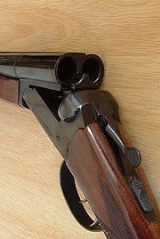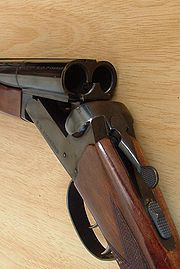
Break open
Encyclopedia

Firearm
A firearm is a weapon that launches one, or many, projectile at high velocity through confined burning of a propellant. This subsonic burning process is technically known as deflagration, as opposed to supersonic combustion known as a detonation. In older firearms, the propellant was typically...
is one whose barrels are hinged, and rotate perpendicular to the bore axis to expose the breech
Breech-loading weapon
A breech-loading weapon is a firearm in which the cartridge or shell is inserted or loaded into a chamber integral to the rear portion of a barrel....
and allow loading and unloading of ammunition
Ammunition
Ammunition is a generic term derived from the French language la munition which embraced all material used for war , but which in time came to refer specifically to gunpowder and artillery. The collective term for all types of ammunition is munitions...
. A separate operation may be required for the cocking of a hammer to fire the new round. Break open actions are universal in double-barrelled shotguns, double-barrelled rifles and combination gun
Combination gun
A combination gun is a break-action hunting firearm that comprises at least two barrels, a rifle barrel and a shotgun barrel, often but not always in an over and under configuration; side-by-side variations are known as cape guns. A ' refers to a combination gun that has three barrels...
s, and are also common in single shot rifle
Rifle
A rifle is a firearm designed to be fired from the shoulder, with a barrel that has a helical groove or pattern of grooves cut into the barrel walls. The raised areas of the rifling are called "lands," which make contact with the projectile , imparting spin around an axis corresponding to the...
s, pistol
Pistol
When distinguished as a subset of handguns, a pistol is a handgun with a chamber that is integral with the barrel, as opposed to a revolver, wherein the chamber is separate from the barrel as a revolving cylinder. Typically, pistols have an effective range of about 100 feet.-History:The pistol...
s, and shotgun
Shotgun
A shotgun is a firearm that is usually designed to be fired from the shoulder, which uses the energy of a fixed shell to fire a number of small spherical pellets called shot, or a solid projectile called a slug...
s, and can also be found in flare gun
Flare gun
A flare gun is a firearm that launches flares. It is typically used for signalling, as distress signalling, at sea or from the ground to aircraft...
s, grenade launcher
Grenade launcher
A grenade launcher or grenade discharger is a weapon that launches a grenade with more accuracy, higher velocity, and to greater distances than a soldier could throw it by hand....
s, air gun
Air gun
An air gun is a rifle , pistol , or shotgun that fires projectiles by means of compressed air or other gas, in contrast to a firearm, which burns a propellant. Most air guns use metallic projectiles as ammunition. Air guns that only use plastic projectiles are classified as airsoft...
s and some older revolver
Revolver
A revolver is a repeating firearm that has a cylinder containing multiple chambers and at least one barrel for firing. The first revolver ever made was built by Elisha Collier in 1818. The percussion cap revolver was invented by Samuel Colt in 1836. This weapon became known as the Colt Paterson...
designs. They are also known as break-open, break-barrel, break top, or (on old revolvers) top-break actions.
Description
A substantial hinge pin joins the two parts of the rifle or shotgun; the stock with its firing mechanism and the fore-piece and barrel, which hold the round to be fired. In some cases the hinging pin may be easily removable, allowing the two portions of the weapon to be compactly and safely stored. In other cases the hinge will consist of a hook over a pin; releasing an auxiliary latch will allow sufficient travel to allow the hinge to be unhooked.A latch is operated to release the two parts of the weapon, allowing the breech to be exposed. A shell is inserted into the breech (up to two for a double barreled shotgun and six to eight for a revolver), and the mechanism is closed and latched. When the operator has pointed the weapon downrange the hammer is pulled back and latched. The weapon is now ready to fire, done by squeezing the trigger.
After firing the round(s), the break action is unlatched and the barrel and forearm are allowed to fall forward. This will cause an extractor catch to remove the spent shell, which is allowed to fall to the ground. The weapon is now ready for a new cycle.
Advantages
The break open action is one of the most compact firearms actions. Since there are no parts to reciprocate, it is much shorter than a repeating firearm, and as built the break-open is generally more compact than other non-repeating firearms such as the falling block and rolling block actions. This compactness means reductions in weight and size, compared to larger actions; this can also allow a longer barrel in a firearm of equivalent size.Since the cartridge extractor or ejector is built into the barrel assembly on break open actions, the breech face is simply a flat plate with a hole for the firing pin to project. This makes break open actions ideal for interchangeable barrel firearms, such as the popular Thompson Center Arms
Thompson Center Arms
Thompson/Center Arms Company is an American firearms company based in Rochester, New Hampshire. The company is best known for its line of interchangeable barrel single-shot pistols and rifles. Thompson Center manufactures muzzleloading rifles and is credited with creating the resurgence of their...
Contender and Encore pistols. The simplicity of the break open design, especially external hammer types, also reduces the cost of manufacture. There are a number of companies, such as H & R Firearms
H & R Firearms
H & R 1871, LLC is a manufacturer of firearms under the Harrington & Richardson and New England Firearms trademarks...
, producing break open rifles at far lower costs than comparable bolt action rifles.
Most firearms are designed for right-handed shooters. Break open action guns typically work the same when used from either shoulder.
Another advantage of the break open action is the ability to insert very long cartridges into the chamber. This allows cartridges of a length impractical in most other designs, as well as easy use of caliber conversion sleeve
Caliber conversion sleeve
A caliber conversion sleeve is a device which can be used to non-permanently alter a firearm to allow it to fire a different cartridge than the one it was originally designed to...
s. It is common to find double barrel shotguns available with conversion sleeves for smaller gauges, allowing the same gun to be used with, for example, 12, 20, 28 gauge, and .410 bore shells.
Disadvantages
The break open design is best suited for non-repeating firearms. To get multiple shots requires either multiple barrels or a revolver cylinder; while this is fairly simple for shotgunShotgun
A shotgun is a firearm that is usually designed to be fired from the shoulder, which uses the energy of a fixed shell to fire a number of small spherical pellets called shot, or a solid projectile called a slug...
s, with double-barreled shotgun
Double-barreled shotgun
A double-barreled shotgun is a shotgun or combination gun with two parallel barrels, allowing two shots to be fired in quick succession.-Construction:...
s quite common and even four-shot designs like the FAMARS Rombo
FAMARS Rombo
The Rombo is a model of four-barrelled break-action shotgun made by Famars in Italy. The shotgun is produced in 28 gauge and .410 bore, and was primarily designed for small-game hunting. It is notable for having a complex action, which allows all four barrels to be fired consecutively and...
available, double rifle
Double rifle
A double-barreled rifle or double rifle is a type of sporting rifle with two barrels instead of one, available in eitherside-by-side or over-and-under barrel configurations. Double rifles are one of the family of combination guns...
s require very precise alignment of the barrels so they shoot to the same point of aim. Modern double rifles are very expensive, and designed for short range use; the barrels are often regulated for ranges under 100 yard for use against dangerous game.
Wear in the mechanism is focused upon the small contact area of the latch, and the breech is difficult to seal properly once the latch wears. In some firearms, such as the Thompson Center guns, the latch was a removable part that could be replaced when worn. Designs without a replaceable latch could be fixed by building up the worn part with a welder
Welder
A welder is a tradesman who specializes in welding materials together. The materials to be joined can be metals or varieties of plastic or polymer...
, then filing back to shape.
Break-open actions are also not as inherently strong as other action types, rendering it capable of withstanding only relatively low pressures
Bolt thrust
Bolt thrust or breech pressure is a term used in internal ballistics and firearms that describes the amount of rearward force exerted by the propellant gases on the bolt or breech of a firearm action or breech when a projectile is fired...
. The action is usually held closed by a single locking lug, usually below the barrel in a single shot or between the barrels of a double barreled gun. The single lug must carry all of the force of firing the cartridge. For shotguns, which operate at very low pressures, this is not an issue.
Some centerfire rifle cartridges, however, can generate pressures that may be too great for a single locking lug, if it is not stout enough. The Thompson Center Contender, for example, was limited to .30-30 Winchester
.30-30 Winchester
The .30-30 Winchester/.30 Winchester Center Fire/7.62×51mmR cartridge was first marketed in early 1895 for the Winchester Model 1894 lever-action rifle. The .30-30 , as it is most commonly known, was the USA's first small-bore, sporting rifle cartridge designed for smokeless powder. The .30-30 is...
level cartridges. To fire more powerful cartridges requires a much larger locking lug, such as that which Thomson Center used on the larger Encore model. Other designs, such as the bolt action rifle which generally uses multiple locking lugs around the perimeter of the bolt to provide an even distribution of the forces of firing, have a much higher intrinsic strength. Since many break open rifles, such as the inexpensive H&R models, are built on large frames originally meant for shotguns, the action is very heavily built and capable of handling moderate to high pressures. Still, belted magnum cartridges such as .300 Winchester Magnum
.300 Winchester Magnum
The .300 Winchester Magnum is a popular, belted, bottlenecked magnum rifle cartridge that was introduced by Winchester Repeating Arms Company in 1963 as a member of the family of Winchester Magnum cartridges. The .300 Winchester Magnum is a magnum cartridge designed to fit in a standard length...
are generally only found in the highest quality, very expensive break action rifles.
Break open designs work best with rimmed
Rim (firearms)
A rim is an external flange that is machined, cast, molded, stamped or pressed around the bottom of a firearms cartridge. The rim may serve a number of purposes, the most common being as the place for the extractor to engage...
cartridges, which can use a solid extractor. Rimless cartridges require a spring-loaded extractor, which can slide out of the way for cartridge insertion, and spring back to engage the recessed rim. While these spring-loaded extractors are found on even inexpensive models, the spring-loaded extractor is not as strong as a solid extractor, and increases the chance of failure to extract.

